Phyllis Cole-Dai's Blog, page 10
March 3, 2021
“The End Doesn’t Always Mean It’s Over”

All at once, our February days in South Dakota feel almost like springtime, with bright sunshine and breezy temperatures in the forties. Birdsong swells at dawn as cardinals, finches, chickadees, and nuthatches tune up for courting. Jihong bikes off to work at the university, unafraid of ice. Giggling children splash in puddles, muddying their pink and blue boots.
I’m trying not to get too excited. Around here, we can have blizzards into May. Still, I’m happy, watching the snowdrifts around the neighborhood shrink down to grass and soil. Our yard, encrusted by a thick blanket of snow only a week ago, is now a palette of tans and browns, interrupted by dabs and smears of white.
The bare patches of earth are a welcome invitation. Here’s my RSVP: I accept, no regrets. I’m ready to pick up sticks beneath the trees. I’m ready to clean up the leaves that got buried by snow, last October. I’m ready to plant those bushes along our east property line. I’m even ready to rev up the tiller and dig up the garden.
“Go ahead,” Winter says, with a laugh. “I dare you.”
I’m ready and willing, but not yet able.
Last year, you may recall, our family joined with friends Ruby and Jim to grow a huge “pandemic victory garden.” We’ve agreed to do the same in 2021. At some point this summer, we hope, we’ll all be vaccinated and able to hang out together in the bean patch or between the rows of pepper plants without fear of COVID. We don’t know when that point will arrive. For my part, I’ll probably stop wearing a mask and socially distancing when Dr. Fauci does.
The five of us had loads of fun in our garden plot, last growing season. Our masks and the space between us didn’t stop us from cracking bad jokes and talking politics and telling stories. When we tired of banter, we weeded and picked through an easygoing silence. Now, all these months later, we’re still enjoying fresh potatoes, carrots and squash, along with produce from the freezer. We munch and simmer and bake and boil. Every bite of our crops tastes of friendship. Once in a while, in a stew, our palate catches a nip of humor or a hint of sorrow. Eating is a celebration of survival.
I’ve been wondering lately: Which aspects of my pandemic life might I wish to continue, like gardening, once it’s over? Better to ask now, I think, than to wait. Better to start mulling it over.
We don’t have to go back to doing everything like we used to. This is a prime opportunity to change—to plan more deliberately what to grow in the garden plot of our existence, and what not to.
Here are just a few changes that I’ve committed to, so far. Professionally, in my post-pandemic life, I want to write more poetry, which this plague prompted me to do. And, though I enjoy traveling, I want to be home more instead of constantly on the road for public engagements. Meanwhile, because virtual events allow me to connect in exciting ways with people around the world, I want to host them more often.
Personally, I want to hug more. I want to invest more time in friendships. (As a lover of solitude, I’ve always found that difficult.) I want to send more snail mail and drop off more goodies, just for fun. I want to dress more casually than I used to. (Is that possible?) I want to wear make-up less often. (Someday I’ll get brave enough to ditch it altogether.) I want to make more music. I want to gain more insight into my own racism and my participation in systemic oppression. I want to cherish each day as my creative playground. (Cherish. Each. Day.) Oh, and did I mention that I want to give more hugs?
These are some of the good fruits that I’ve harvested from my pandemic life. To be honest, I’ve reaped some bitter fruits, too. For one thing, it might be a while before I can enter a crowded elevator without my mind screaming “No!” But that’s okay. I can sort the bitter and the spoiled fruit from the sweet. Whatever isn’t worth saving, I’ll bury in the ground; compost, you know. Nothing will go to waste.
If you doubt that anything in your pandemic life is worth keeping beyond it, I ask you to reconsider, with an open mind. For curiosity’s sake, if nothing more. Play with this question: Beneath the melting snows of this past terrible year, might there be fertile patches of earth waiting to be seen?
February 23, 2021
“Glimpses in the Mirror”
Here I am, on retreat again. One year has elapsed since the Muse woke me up on retreat in San Diego, delivering For the Sake of One We Love and Are Losing. At the time, I felt...
The post “Glimpses in the Mirror” appeared first on Phyllis Cole-Dai.
February 22, 2021
Glimpses in the Mirror
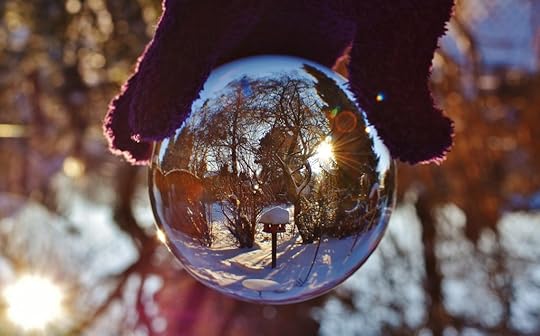
Here I am, on retreat again.
One year has elapsed since the Muse woke me up on retreat in San Diego, delivering For the Sake of One We Love and Are Losing. At the time, I felt cocooned. The coronavirus seemed faraway, and though I was tracking the outbreak, I didn’t anticipate a full-blown pandemic. Nor did I appreciate how seriously the social ills in my country would complicate its response to the virus, if it ever spread here.
How sorry I am to have been so wrong.
Over the past year, I’ve inscribed countless messages of care and encouragement on books for dispirited readers. I’ve answered a river of emails. I’ve sent Staying Power every Sunday. I’ve written poems. In troubled times like these, words can feel like chaff in the wind. Yet words are what I most have to offer. I must have faith in them.
Coming on this retreat, just 45 minutes away from home in Sioux Falls, was itself an act of faith. I rise each morning, anxious to work. No email, no social media, just me and this patchwork quilt of a manuscript. I’m pleased with my progress, piecing it together. Yet, if I’m honest, after eleven months of pandemic isolation, this ten-day dive into solitude and silence feels rather like a bellyflop.
I’m emotionally spent. Since my father’s death in January from COVID-19, Mom has been hospitalized twice with pain in her chest and shortness of breath. The pandemic has put her, like so many elders, through the proverbial wringer. Resilient as she is, she sometimes can’t talk on the phone without breaking into tears.
“Go ahead and cry,” I tell her. “If I were there with you, we wouldn’t have to talk. We’d just—”
“Hold each other,” she says, finishing my sentence.
But I’m not there. And I can’t hold her. Not in the way we both want. Not in the way we need.
Since coming on retreat, I’ve been dreaming of the dead—Dad and old teachers, mostly, alive and well. I’m thrilled to see them, to be with them, and (more rarely) to touch or be touched by them. Yet I can’t quite make sense of them. They show up in places they don’t belong. They speak words I can’t understand. They look at me as if I’m not who I was.
They’re right, of course. I’m not who I was. None of us are. This pandemic is reshaping us. We won’t be able to gauge just how we’ve changed, or how much, until we gain the perspective of time. But I’ve caught a couple glimpses in the mirror as my midwinter retreat draws toward a close. It stands in stark contrast with previous retreats, especially last year’s. Those ten days remain luminous in memory, coming as they did, just before the world utterly changed. In juxtaposition, how could this retreat in Sioux Falls not seem dim?
I feel a bit lost. I know exactly where I am in this manuscript. I know exactly where I am in this town. Yet I’m less at ease here than I ever was in San Diego, where I had no blueprint for the novel I was drafting, and I had to ask directions to the nearest grocery store.
I experience my sense of displacement in my body as a hollowness in my chest, a fuzziness behind my eyes. But when I trace the sensation further in, I pass into a soft, dense fog of melancholy, formed in the chill of isolation. I hadn’t known it was there.
Typically I luxuriate in “alone time,” but I’m no hermit. In San Diego, when weary of my own company, I’d slip on a jacket and head to the beach to people-watch. I’d indulge in meandering strolls, exchanging pleasantries with residents hanging out in their yards. Here in Sioux Falls, I have no beaches and, in this arctic cold, no walks. But even if the weather did let me venture out, if I met with anyone on the sidewalk, I’d jaywalk across the street to avoid them.
Maybe this is one change the pandemic has wrought in me: I need to be around people more than I used to, and I can’t.
If human presence is a key ingredient missing from this retreat, another is the stimulation of new surroundings. Travel is an encounter with novelty. It always shakes me up like a happy can of soda. When the Muse pops me open, creativity explodes, and the fizz outlasts the foam.
Take me far enough away, then plonk me down among the locals. Let me bask in their music. Let me savor their food. Let me soak up how they talk and dress and dance. Let me lose myself in their wild places. Let me laze in their cafés. Let me see how they toss their children into the air, and how they tell stories, and how they wipe away each other’s tears. Let me hear how they sigh when the sun goes down. Let me fall in love with them and, through them, with the world again. Falling in love, I can’t help but write.
Diversity catalyzes my spirit. Monotony puts me to sleep. If I were to stay much longer within these bland gray walls in Sioux Falls, in the coldest season of the year, in the middle of a pandemic, I’d enter hibernation.
So long as I’m awake, though, I’ll be watching for the Muse. Even as I write these words, I can feel her hanging around, just out of sight. Can’t you?
Don’t worry that she hasn’t made a dramatic appearance, like last year. How the Muse comes depends on what she’s bringing. She doesn’t carry stardust the way she carries fire.
Patience, my friend. It’s time to exercise our staying power. The Muse is a lot like life. She doesn’t like to be rushed.
Or could it be that, by sleight of hand, the Muse has already brought her gift, and she’s just waiting for us to find it?
February 2, 2021
“To Walk the Labyrinth of Peace”
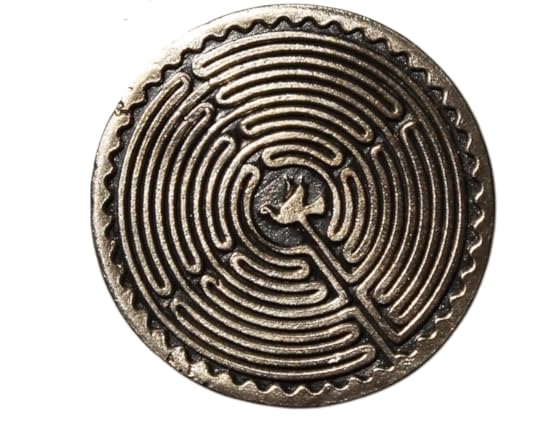
Some years ago, a dear friend gave me the gift of this bronze pendant. It’s one of the few pieces of jewelry that I own. Along with my wedding band, I wear it every day. I lift it over my head each morning as a ritual and tuck it inside my shirt. I don’t need other people to see it. It’s enough, knowing it’s there.
This is a peace pendant, cast from an alloy made from recycled nuclear weapon systems. (How’s that for upcycling?) Wearing it reminds me of my friend and the bond between us. Beyond that, it reminds me of the Peace from which I came and to which I’ll one day return. It further reminds me of my life’s purpose: to use my creative skills to help build a more harmonious world. Finally, this pendant reminds me to take up my life’s work anew each morning, starting within the realm of my own mind and heart. That’s where I most immediately contact the Peace that is my source.
I don’t have to stop and think about all these things as I hang the pendant around my neck. By now, they’re practically fused into the metal.
The pendant feels indestructible. It dangles over my heart, summoning my attention throughout the day and strengthening my aspirations. It’s a keepsake, amulet, symbol and seal, all rolled into one.
As you can tell, this pendant features a labyrinth, an ancient image representing a pilgrimage, a journey, a life of spiritual progression and growth. Many labyrinths are big enough to walk through. You can proceed without worry along the meandering path because, unlike in a maze, you can’t make a wrong turn or hit a dead end. This isn’t a puzzle to solve or a trap to escape but an experience through which to quiet your mind, center your spirit, and contemplate, meditate, pray, imagine … be. You can’t get lost in a labyrinth, though some people say that you lose yourself there. (I’d rather say that you learn to you live yourself there.)
At the center of this labyrinth is a dove of peace. The dove isn’t separate from the path, but very much of it. So, no matter where you are in the labyrinth, you’re still connected to peace. Once you reach the dove, you can abide there only so long before the noisy, chaotic world pulls you back onto its track. But even when you leave, peace remains with you. In this labyrinth (as in everyday life, with practice), peace is every step you take. Peace is the ground you walk on.
Yet this labyrinth isn’t untroubled. Look closely, and you’ll see that the path of light is surrounded by the dark. Indeed, darkness is what renders the pathway distinct. The hardships and heartaches of this world, which we so often resent, actually reveal the direction to go. Sometimes the way forward may seem straight, but in reality even the straightest stretches curve. This is likely for our benefit. The curves slow us down, putting us more in sync with the natural order and its cycles of life, so full of rounds. Indeed, the labyrinth sometimes leads us so far away from where we hope to get to that we begin to doubt we’ll ever arrive. Yet we can’t help but arrive, if only we proceed with faith along the ground we’re given.
See the waves swelling at the rim of the pendant? In my imagination they evoke the primordial waters from which all life emerges; the waters of the womb; the waters of initiations and cleansings and fresh starts and rising tides. But they also put me in mind of overwhelming floods and stormy seas, which we must all endure and navigate, more than we’d like.
These waves, here on the edge, are the only part of the pendant’s design not hemmed in by darkness. Here, in these waters, light has the upper hand, as if to say, “I contain everything within me.”
What is this “outermost” Light that contains everything else?
That question isn’t for me to answer. I’m content to let mysteries remain Mystery, without assigning a name to it or trying to expound on it. Powerful as words can be, when speaking about the Beyond, I prefer silence.
Yet I rejoice in the Light that contains every other thing. I know for a fact that it’s there, not because I believe in the idea of it but because I experience the fact of it, every day. Even in the pitch-black cave of the darkest dark, light is there, guiding me. It’s in my groping fingers and in my faltering feet. It’s in the eye of my intuition. But do I trust where the unseen walls and ground are taking me? Do I trust the labyrinth of life to lead me to the center?
I invite you to settle yourself for a few minutes in order to “walk” the labyrinth of my peace pendant. Prepare yourself to focus on what’s in front of you. Then, using a fingertip, slowly trace the path from start to end.
“But where’s the start?” you might be wondering. “Here at the edge, or there in the middle?”
The “start” is wherever you choose to begin. Head from the waves toward the dove, or from the dove toward the waves. Once you get where you’re going, rest in the silence of your soul a while before making your way back out into the world again.
Eventually the labyrinth teaches us that “beginnings” and “endings” exist mostly in our minds; that every start is also an ending, and every ending is also a start.
Here we are, speaking of circles again. Maybe that’s why this pendant is round?
January 26, 2021
“In Tribute to Lighthouses”
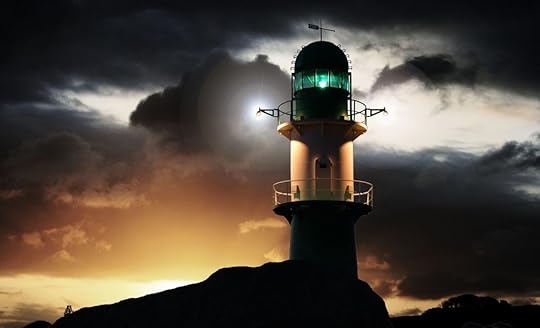
I live a long way from any major body of water. The nearest is Lake Superior, almost 350 miles from where I sit. Yet lately my mind has been preoccupied with lighthouses; more specifically, with how we can be lighthouses for one another.
We’re not born being lighthouses. In fact, we all begin our lives at sea, as passengers on our mother’s ship. In childhood, if we’re lucky, we’re content to frolic and play on deck as the ship rides the rolling swells. We don’t give much thought to where we’re going. As we get older, we graduate to the ship’s crew. We work on mastering the skills necessary to keep our boat afloat and to skipper it safely from one harbor to the next. In due course, if our soul is stout, we might even become the boat. We carry incredible loads through life’s stormiest waters without breaking apart.
Over time, circumstances require us to move back and forth among these seafaring roles. When facing a debilitating crisis, for example, we might revert to being a passenger, relying solely on the care of others. When those we love are in trouble, we might step up as first mate or captain. We might even volunteer to be the boat.
Whatever our situation out at sea, we’re always blessed by the sight of lighthouses on land. The playwright George Bernard Shaw once described lighthouses as the “most altruistic” of all buildings, because their only purpose is to serve. From the coasts of lakes and oceans, they shine up to 25 miles over the water, assisting navigators on their passage and warning boats away from jutting rocks and treacherous reefs. Most happily, they welcome vessels into port.
Life has a way of building some people into living lighthouses. Like their actual counterparts, they seem to exist first and foremost to serve, by their own free choice. They stand strong at the water’s edge, casting their light of love and understanding, of courage and hope, through the dark. Their light is limited—they can’t illuminate the entire sky—but what modest light they do offer, especially when joined to the light of others, helps guide us all to safety. It helps bring us home.
Not all lighthouses look the same. Indeed, the more distinctive they are, the better. So while one lighthouse might be a tall, white tower, another will be short and squat. Or square. Or eight-sided. Or painted with its own pattern of diamonds, stripes, or spirals. One lighthouse might be made of stone or brick, another of concrete, steel or cast iron. Even the shaft of light emanating from its lantern will have its own peculiar signature. It might be fixed and steady; it might revolve, flashing at different intervals, or in unique rhythms, or in diverse colors. The same is true of living lighthouses—no two alike, all of them valuable, all keeping watch over the world.
I jotted down the names of some living lighthouses I’ve been guided by throughout the years. (You might want to do the same, for fun.) On my list were teachers, mentors, friends who have so steadfastly companioned me, farmers and healers, changemakers and visionaries and creatives who have inspired me, clergy of many faiths, elders of many races, strangers into whose shaft of light I only ever bumbled once but was forever altered.…
For as wonderfully one-of-a-kind as these living lighthouses are, they share many basic traits. When I picture them as a group, this is some of what I see:
They devote their light to others, not by controlling them or by telling them what to do, but by helping them to gauge where they are.Shining seems part of their nature. They can’t not shine. They don’t have to go anywhere or do anything special to accomplish their purpose. They just beam out from their little patch of earth.They don’t try to hide their light, or pretend they don’t have it, or judge themselves unworthy to shine.They don’t call attention to themselves or what they do. They just go about their business, as surely as the stars above. They regard themselves as utterly ordinary, humble instruments through which the gift of light can be magnified.They don’t care whom their light reaches. No matter the ship or its flag or the identities of those aboard, they always shine the same.They’re comfortable standing alone in the dark. They even expect to. After all, lighthouses are rarely built right next to each other. But they trust that they’re in good, if invisible, company. Others too are shining, elsewhere along the coast.They’re resilient. They’re not indestructible, but they’re able to withstand punishing weather.They require careful tending. I can’t overstate this. Not even the most powerful or dedicated lighthouse can function without a keeper. If it’s to go on shining, someone must lovingly replenish its fuel, polish its lens, clean its windows.Last week’s presidential inauguration ceremony included a dynamic poem by Amanda Gorman, who, though only 22 years old, is already a living lighthouse. She concluded her poem:
For there is always light,
if only we’re brave enough to see it
If only we’re brave enough to be it
This world, so beautiful yet so battered by bewildering storms, doesn’t need more light to navigate by. The light we need is already here. But, out at sea, do we have the eyes to see it, beckoning from shore to shining shore? Do we have the eyes and the wisdom to follow it? Indeed, do we have the lives to become it—to learn to be lighthouses, built to bring one another home?
You know the answer.
January 18, 2021
“Across the Dark and Swirling Field”
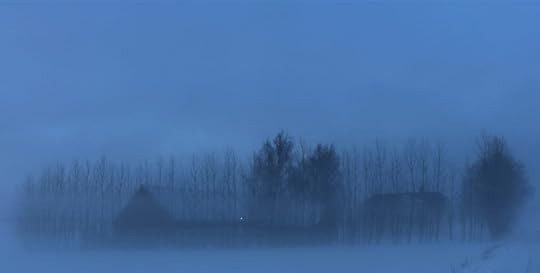
On January 26, 1978, my family wakened to the nightmare of the “White Hurricane.” The strange fog of the previous evening had turned overnight into an unseasonable thunderstorm. Then, as the temperature plummeted in the early morning hours, the rain changed to sleet, coating everything with ice. Cars and trucks spun into ditches. Power lines snapped. Transmission towers crumpled.
Last came the snow, about a foot of it, driven by sustained hurricane-force winds. They gusted up to 100 miles an hour, ripping off roofs, blowing out windows, toppling trees, and bringing down hundreds of utility poles. They created drifts deep enough to bury a semi on the turnpike. The trucker survived in his cab by eating snow until his rescue six days later.
By candlelight that morning, I watched my mother pack a picnic hamper with food for my father and older brother David. Bundling themselves into winter gear, they aimed to walk three miles across the countryside through the blizzard to our farm. Crazy, right? But they had to preserve our swine herd, our family’s only source of income. When they disappeared out the door into the churning white, I didn’t know when, or if, I’d ever see them again.
I was sophomore in high school. Realizing that the electricity in our house wouldn’t be restored soon, I went to the cellar with my younger brother Barry to crank up the wood-burning furnace. Our hearts fell when we walked into the furnace room. Typically stacked full of wood in mid-winter, it was empty except for a few chunks, all too fat to fit through the furnace door. We had no tools to split them.
We thought then of the modest pile of firewood behind the house, fuel used on rare occasions when we burned the fireplace in our den. I offered to retrieve some.
As I stepped out the back door, the brutal cold shocked my system. Even protected by my neck gaiter and woolen scarves, my lips turned numb. The bitter air so cut my lungs, I tried not to breathe. The wind chill, I learned later, was sixty below.
Ahead of me was a vague heap of white within the white of the blizzard: the woodpile, ranked against the rear of the house, just before the ground dropped fast away toward the river. I was so close to it! But the wind was so strong against me, I couldn’t advance.
I circled back around the house to approach the pile from the opposite direction. As I came around the last corner, the gale grabbed me like a rag doll and skated me across the icy ground. At the wind’s mercy, I spilled hard, time and again, and skidded a ways down the slope on my belly or my back before stopping. I was terrified that if I slid all the way down the steep hill, I’d never be able to climb back up.
Somehow I finally made it to the pile. My frantic hands burrowed into the snow, only to discover that the pieces of wood were encased in ice, as if in cement. I pounded at them with my gloved fists. I kicked them with my boots. It was useless. There would be no fire to keep us warm.
Mom, Barry and I sequestered ourselves in a closed room beneath quilts and blankets. Our breaths were frosty plumes. We rationed our food and candles. When the radio died, we listened to the rattling of the house’s bones, wondering about Dad and David.
Late on the blizzard’s second day, the storm subsided.
On the third day, we heard the distant roar of a snowmobile. We hurried to a window and scratched the frost off the pane to look out. When the sled skied into our yard, I teared up with relief. The man aboard was one of many volunteers dispatched from town to check on rural residents.
The next day, by magic, a small load of firewood appeared at our door. But our house was still nippy when Dad and David arrived home, stiff and shivering, so exhausted they couldn’t think straight. The morning they’d vanished into the blizzard, they became disoriented almost at once. What saved them was bumping up against a neighbor’s barn, less than a quarter mile from our house. The neighbor delivered them safely to the farm on his monster tractor. They labored without rest to keep thousands of animals alive until danger was past. Dad, a giant of a man who never cried, sobbed himself to sleep. The whole house trembled with the sound of it.
Today, almost 43 years after Ohio’s “Storm of the Century,” it’s blizzarding around my house here in South Dakota. And that’s not the only storm raging. As I consider the troubles in our nation, sometimes I feel like I’m back on that frozen slope behind my homeplace, desperate for wood, unable to breathe deeply, buffeted by the wind, powerless to break through the ice.
Back in ‘78, I often peered out across the dark and swirling field toward the Martins’ house, set back a long lane. Was that a glimmer of light in our old friends’ window? By some miracle, was their power back on? Were they enduring the blizzard, poor health and all? (They survived in the shelter of their chicken barn.)
Now, my friend, I’m peering through my snow-covered windows, keeping watch for you. And look, what do I see across the dark and swirling field of our shared life? Bright light, gleaming from all your windows! Your power isn’t back on—it was never knocked out in the first place. No storm will ever put it out, because your truest power, like mine, springs from love. And of that power source we have an infinite supply, within and beyond all the vicissitudes of this world.
(Image by Lena Lindell from Pixabay)
January 11, 2021
“All Our Beautiful Dots & Lines”
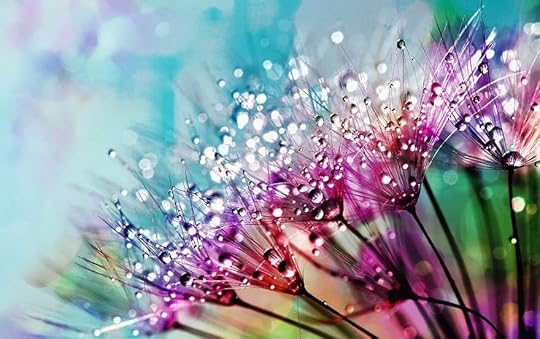
What a week this has been! On Sunday, my father passed away from COVID-19. On Monday, my mother tested positive for the virus—so far, thankfully, she has no symptoms, but the initial news was a hard blow. On Tuesday, I labored over the first draft of Dad’s obituary. On Wednesday, as I was planning his online memorial service, thousands of my fellow citizens attacked the U.S. Capitol. Lives were lost. The fragility of our democracy was on full, ugly display.
I won’t continue with my week’s catalogue of woes. You get the picture. Maybe your week felt much the same.
But then, in the midst of my grief and dismay, beauty began to appear. Gifts arrived from far and wide, from friends as well as people I’ve never met: a bouquet of flowers … lovely cards, all of them kind, some handmade or featuring original art … poems by Jane Kenyon, Ellen Bass, Mary Oliver, John O’Donohue, Diane Der-Hovanessian, and more … a turquoise heart of glass … carefully selected sacred texts, from diverse faith traditions … heartfelt emails … calming recordings of music … cartoons … a peace lily, standing almost four feet tall … Someone even mailed me one of my own condolence cards, containing the soothing poem I’d dreamed on the cusp of the pandemic, when Dad was suffering through another tough stretch. To receive that poem from outside myself in these difficult days, even as I had in the dream, was a tremendous comfort.
These infusions of beauty have sustained me. They’ve prompted cleansing tears. They’ve lifted me out of myself. Some have even caused me to laugh. All have strengthened me to carry on, with—and for—those I love.
I so often ask myself, what prompted this woman or this man to reach out in this way, the light of soul shining through? Why, in tough times, does instinct turn us toward beauty? I don’t need answers to these questions. I raise them in wonderment and gratitude, content to float on the mysteries of grace.
One gentle soul who wrote me was Pavi Mehta, the editor of DailyGood. Until now, our slender correspondence has always been work-related. But a stunning series of synchronicities over the past couple of weeks has deepened our connection. I can’t take time to tell you the full story. I can, however, follow Pavi’s lead and introduce you to the beauty of kolams.
Kolams are a ritual art form from South India, where Pavi was born. This photograph shows a sublime example. “These patterns of dots encircled by flowing lines,” Pavi says, “are drawn on predawn thresholds every morning by millions of women. The dots represent the beginning of things—the origin point of life. The lines represent the flow of life, and a kind of infinite continuity.”
Traditionally made from rice flour, kolams are food for ants and other tiny life forms. But their purpose doesn’t stop there. In Feeding A Thousand Souls, Vijaya Nagarajan says that a woman’s positive intentions while working on a kolam “are believed to actually make a difference in people’s lives.” The powerful (even divine) energy of her intentions transfers from her hands to the art, “to be picked up by the feet of passersby and transported throughout the day.”
Pause a moment and let that sink in. Imagine your hands, creating such sacred beauty as a routine act. Imagine your feet, and your neighbors’ feet, and strangers’ feet, deliberately walking through such beauty, that they might track some of it through the world. Imagine your heart-mind, constantly tuning in to whatever beauty it might meet, or bring forth, next.
For all their exquisiteness, kolams exist for merely a day before their makers sweep them away. In anticipation of another dawn, the women sprinkle the ground with water, then form fresh, original designs to greet the sun. It might take them minutes. Or hours.
“These patterns,” Pavi says, in gorgeous phrasing, “flow spontaneously through fingers … in that thin sliver of no-man’s-land where the visible and invisible worlds meet, where darkness and daylight press their palms against one another.”
I wonder: What would this trembling world look like if more of us started each day by ritually acknowledging our own power to make a difference? If more of us dedicated ourselves to spreading beauty, for the sake of promoting good?
Today, on the strength of all the beauty that has rained down upon me in my time of sorrow, I press my palms together and bow to you. I bow to the beauty that you are. I bow to the beauty that you yourself need. I bow to the beauty that you give. Some beauty you give knowingly; some, you give unaware. It’s all the same.
On the winding journey of your days, I urge you to make beauty your companion. “What beauty?” you ask. The beauty of poems and stories, of music and art, of film and dance; the beauty of nature; the beauty of food and fabric and fragrance—everything that delights and humbles your senses; the beauty of kinship and community—of a hand held, of laughter shared, a testimony heard, a struggle joined; the beauty of solitude, of silence, of introspection; the beauty of mystery, and the infinite ways that the intricate dots and graceful lines connect us all within the flow of life and death and Life Again….
What beauty? Seek it out. Invite it in. Let it be. Set it free.
January 4, 2021
“A Great Stack of Wood”
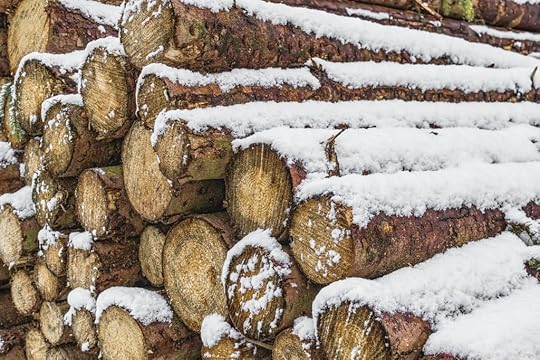
I wasn’t sure if I could talk to you today, especially about this. I don’t want to impose my grief. But I’ve promised myself always to be real with you. This is as real as it gets.
You’ve had your own losses. And right now, the entire country seems adrift on an ocean of misery and sorrow. We have to talk about what hurts. We have to help one another through.
My parents live in an elder care community in North Carolina. This past Monday, Mom received her first vaccination against COVID-19. By sad irony, the very next day Dad entered hospice care, suffering from the virus. He isn’t expected to live long.
Scattered across the country, my brothers and I are struggling to companion my parents through Dad’s final hours. How to be present where you can’t be? How to comfort? How to make farewells?
In this room where I’m sitting, the quiet ticking of the clock drowns out the howling of the wind through barren trees. Snick…. Snick…. It punctuates the low drone of traffic creeping along the snow-covered street. Snick…. Snick…. I try not to listen.
Since the start of the pandemic, everyone in our family has feared for Mom and Dad. Both are in their eighties. Dad’s health, in particular, has been fragile for years, requiring skilled nursing. We’ve been grateful for the strict quarantines and safety protocols followed by their elder care community.
All year long, those measures protected Mom and Dad. Then, on Christmas Eve morning, just as the COVID-19 vaccine was becoming available, Dad tested positive.
Hearing the news, I was gripped by a sudden urge to clean. Ordinarily, household chores aren’t near the top of my to-do list. But that day, setting our house in order felt like binding up my stricken heart.
Since Christmas, dreams about Dad have crowded my nights. Sometimes they wake me up. More often, memories of them surface during daylight hours. They aren’t nightmares. They’re just … true. They follow me around like old dogs, begging for attention as I read, write, fold laundry.
In one dream, I’m racing toward Dad across the landscape, feet flying as they never have before, even back when I was a sprinter on the track team. I’m running not from worry or from desperation but for sheer joy. I feel no pain in my joints, no weariness at the distance I must cover. I’m as free and fast as a cheetah on a savanna. Strangely, though, my running never gets me any closer to Dad. He’s always within sight, a younger, able-bodied version of himself, but he’s far away. Unreachable.
In another dream, I walk into a place where Dad has been living—a small farmhouse, perhaps, or a cottage. I find the interior of the dwelling blanketed by sawdust and heaped with wood chips. Dad, I suspect, has been cutting trees into firewood to feed a huge furnace. By the look of things, he must have stacked up cords and cords of wood somewhere. I don’t stop to wonder how he could have done all this from his wheelchair. I grab a shovel and begin scooping wood scraps into a wheelbarrow (yes, cleaning house again). But for every shovelful I toss off the couch or the floor, another appears in its stead. Where’s all this wood coming from? I ask myself. At once the dream supplies the answer, as if it possesses a voice: “This house isn’t full of wood chips. It’s full of would chips.” As in: Dad, I would be with you, if I could. I would ease your suffering. I would sit with you through the long, dark night. Would…. Would…. Would…. Would.…
The clock’s ticking is more regular than a heartbeat. It runs on a battery, just like Dad’s pacemaker.
Our dreaming selves know better than our conscious minds that a frontier exists between life and death, not marked on any map. In that space, Dad is both full of vigor and passing away; both here and beyond reach. What Was is all mixed up with What Is and What Will Be. We experience this same frontier even in the mythical turning of the new year, don’t we? What we’re running toward is partly behind us. What’s behind us is partly ahead of us, and it isn’t standing still.
I love Mom and Dad. But as unique as they are in my eyes, they’re also the Everywoman and Everyman of this pandemic. They represent all the people who, one way or another, have been afflicted by COVID troubles. Most will survive. Millions will not. None of us with half a heart will emerge unscathed.
Yesterday, through the phone, I played Dad some of his favorite hymns on the piano. “I love you,” I said through tears, “but it’s time to go.” I hoped that he might hear and understand my words; that, being reassured, he’d give up the fight and slip away in peace. But I didn’t really expect him to. He’s a tough old farmer. He has a mind of his own. Sheer stubbornness, twined with his love for Mom, has kept him alive for years.
Yet today, suddenly, he’s scarcely breathing. Maybe some part of him did listen. Maybe, despite my dream, he had been reachable.
I picture Dad snug and warm under the colorful fleece blanket my family sent him from South Dakota for Christmas. His gift arrived a week ahead of the virus. He’s said to have “glowed” when he saw it. I’m comforted to imagine that blanket of ours helping to swaddle his body as his spirit returns whence it came.
Now, if you’ll excuse me, the clock’s still ticking. I have some heavy-duty shoveling to do. This place is full of wood scraps, and the sacred fire in the furnace needs tending. Thanks, Dad, for teaching me the importance of feeding it. You always cut a great stack of wood.
December 21, 2020
“Living the Long Wait”
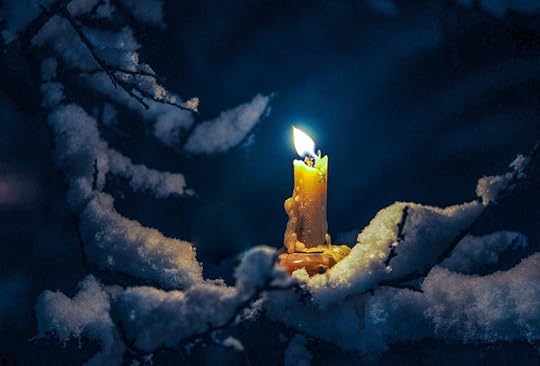
Do you have any crazy holiday travel stories? Our family has a chest full. At Christmastime we typically trek back east to visit my parents and other relatives. The pandemic will force us to stay home this year, but we’ve been swapping memories of Christmases past, when we set off with high spirits, crossing our fingers against bad weather, bad highways, bad flights, and bad-tempered fellow travelers. If our wishes for good luck had always come true, we’d have only boring stories to tell.
For me, our most memorable Christmas trip dates to when our 18-year-old son Nathan was a tiny baby, only three months old. I flew with him cross-country to Kentucky, where my parents then lived. Jihong, my dear wizard of travel deals, had booked himself on a separate flight to save us money. He arrived in Kentucky on schedule. Lucky him.
I won’t bother you with the details of that nightmarish trip—the delays, the missed connections, the cancelled flights, the unmoving lines at ticket counters, the re-routings, the last-minute gate changes…. There I was, lugging Nathan through one airport after another, toting a heavy diaper bag over one shoulder and rolling a carry-on behind me.
In those days, we had no cellphones with which to re-book, to communicate, to distract and entertain. How time crawled! Hours of disappointment, confusion, frustration, and tedium drained my energies until I couldn’t think straight. My body ached from endless walking and standing, baby and gear in tow. I had no opportunity for a break. I couldn’t close my eyes even for a few minutes, lest I fall asleep. I had to keep my wits about me, for Nathan’s sake and my own.
In the middle of the night, I was in a throng of weary travelers near the departure gate in the latest airport I’d never expected to be in. I felt trapped in a horrible dream—surroundings surreal, senses distorted. Tired tears dribbled down my cheeks. I rocked Nathan back and forth, humming and singing in his ear, afraid I’d break down and weep. I needed food. I needed rest. I needed relief. All he needed was … me. But was I enough to get us through?
My exhaustion and distress must have shown, because that’s when a middle-aged woman standing nearby said, “Would you like me to take your baby awhile so you can rest your arms?”
Her question made all the difference. I surrendered. The brief respite that woman provided enabled me to face what remained of that long wait.
Eventually Nathan and I boarded our next plane. Eventually the sun came up again. Eventually we fell into the loving arms of Jihong and my parents, 24 hours late.
As I write this, we’re all approaching the winter solstice—the longest night in the longest, strangest year in memory. We’re in an immense time of waiting. We wait for the wheel of the seasons to turn; for light to lengthen our days again. We wait for holiday celebrations. We wait for vaccinations. We wait for post-pandemic reunions. We wait for recovery from disruptions and losses of every sort under heaven. We wait for discovery of what life will be like on the other side of Now.
No matter how tired we may feel, or how dark our night has become, we can’t rush the waiting. It will last as long as it lasts. So how do we endure it? How do we find the patience?
I’m no expert on this subject, believe me. But that long-ago Christmas journey began to teach me a few things about how to live through “the long wait”:
Watch anything but the clock (or the calendar). Keep yourself occupied. Give your attention to things that matter. Do small tasks mindfully. Immerse yourself in play. Hum and sing. The more you pour yourself into any activity, the less you’ll stew.
Embrace the long wait as just another part of your life. It might be inconvenient, grueling, or downright hellish, but it’s yours. Live it as best you can, even with tears dribbling down your cheeks.
Have faith in yourself. The long wait may create problems and doubts; it may excite fears and worries. You’re bigger than them all. You’re love in human form.
Accept (or ask for) help. A woman in an airport wants to hold your baby so you can rest. A friend asks to lift your spirits by Zoom. A neighbor volunteers to shovel your snow. A relative suggests dropping off a meal. Say yes to it all! You don’t have to wait alone.
Trust the big picture. The infinite web of this mysterious universe connects us all. Your waiting here might make all the difference there, preventing a tragedy or producing a miracle. Trust the possibility.
Remember that it will end. Even after the darkest, bleakest night, the sun always comes up again. How will you value your life in the meantime? “If you can wait and not be tired of waiting,” Rudyard Kipling says in his famous poem “If—”, “yours is the Earth and everything in it!”
Let Kipling’s words sink in: “If you can wait and not be tired of waiting.… yours is the Earth and everything in it.” Even here, in the deep night of what can only be endured, the shining world comes forth in glory to meet us. Blessed be the dark that prepares us to see!
December 14, 2020
“Deliveries of Light”
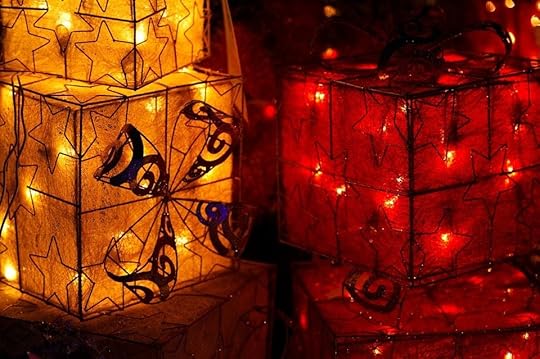
A reader of “Love Letter to America” wrote to me and said, “What wonderful words, but who will take them to heart? Those who understand already understand. Those who do not never will.”
Do you sometimes feel this way, too? I do. I often express my despair to those I’m closest to.
Yet I hope that we can resist caving in to despair and resignation, no matter how weary we become of feeling estranged from a society where we might have once felt at home; of caring about “the real stuff” when so few others seem to; of seeing things get worse when we’re trying so hard to make them better; of feeling isolated, small and “different,” as if we don’t matter or belong….
“When despair for the world grows in [you],” to paraphrase Wendell Berry’s poem “The Peace of Wild Things,” “and you wake in the night at the least sound / in fear of what [your] life and [your] children’s lives may be,” take a rest. Follow Berry’s example and turn your attention to nature. Tend to the body. Breathe a little deeper. Indulge in simple pleasures. Read what helps. Listen to what soothes. Do the next kind thing. Create. Seek the consolation of someone who loves you… It might take surprisingly little for you “to rest in the grace of the world, and be free.”
If your despair persists, though, I invite you to investigate its origins. You may find (as I usually do) that the taproot of despair stretches into the sticky clay soil of desires and expectations: “If I say this, or if I do that, then what I want to happen will happen.” We tend to invest ourselves in such thinking without realizing. Then, when the outcome proves other than what we’d wished for, we’re disappointed. One disappointment after another becomes an ugly shrub of despair. Once it takes root, it’s hard as the devil to pull up. It crowds out hope. Yet we’re the ones who planted it and watered it to keep it alive.
I remember a February day in 1999 when my friend James Murray and I were living by choice among the street people of Columbus, Ohio. (We wrote about our experiences in The Emptiness of Our Hands.)
Already by our third day on the streets, we were exhausted, footsore, and dazed by our own fragmentation. We hadn’t expected to fall apart so soon. Truth be told, in our ignorance we hadn’t expected to fall apart at all.
On the morning of February 19th, James led me onto the Broad Street bridge in the heart of the downtown. “Follow me,” he said. “I have a surprise.” In the preceding hours, we’d each been scavenging on our own. I thought maybe he’d found a stash of blankets, which we desperately needed. Or maybe he’d stumbled onto someplace secure and warm enough to sleep that night.
Halfway across the bridge, he stopped and leaned against the rail. For a few minutes the two of us watched the river swirling muddy brown down below. Then he yanked off a glove and reached into his coat pocket.
“Hold out your hand,” he said.
He laid a milkweed pod in my palm. Dead-brown, brittle, full of white seeds. I looked at him, puzzled. He had another pod in his hand. “I thought we could release the seeds over the river,” he said. “Kind of a ritual: for each clump of seeds, we can name something we’ve got to let go, in order to keep going out here.”
“Wonderful,” I exclaimed. I tugged off my gloves, better to grasp the tufted seeds.
“You first,” James said.
“I let go of my need for a good night’s sleep,” I said, casting a cottony fluff.
“I let go of my need for three meals a day.”
“My need to be warm.”
“To feel safe.”
“To have money.”
“To be clean.”
“To know what’s coming next.”
More and more white wisps of milkweed down floated over the churning water like tiny parachutes. A few would make it to land. Maybe one of them would survive to become a milkweed plant. And maybe one day a monarch butterfly would lay her eggs on the underside of its leaves.
“I let go of my need to feel loved.”
The necessity of the lowly milkweed: a monarch butterfly will lay her eggs nowhere else.
“I let go of my need to be me.”
One thing that James and I didn’t let go of by name during that morning’s ritual on the bridge was our need to control the outcome of our words and actions. Yet that became one of the central lessons we gained from our season on the streets.
The practice of letting go of the outcomes of our actions is one way to change the mechanism of our despair. If I write a “Love Letter to America,” I dare not expect America to understand it. Or agree with it. Or change because of it. America might not even read it. But I’ll still write that letter in hope. I’ll still say what I need to say and do what I need to do, for the sake of myself and everyone I care about—including you. What happens thereafter isn’t up to me.
You and I are mail carriers from a world of light. Neither snow nor rain nor heat nor gloom of night will stay us from the swift completion of our appointed rounds. When we drop our envelopes and packages of light at someone’s door, we won’t stand there and wait to see if they’re retrieved. We won’t watch them being opened. We won’t witness the reactions of the recipients and form judgments on that basis. No, we let go of all expectations. Day after day, house after house, we’ll deliver some light from our mailbag, then continue on our way.



